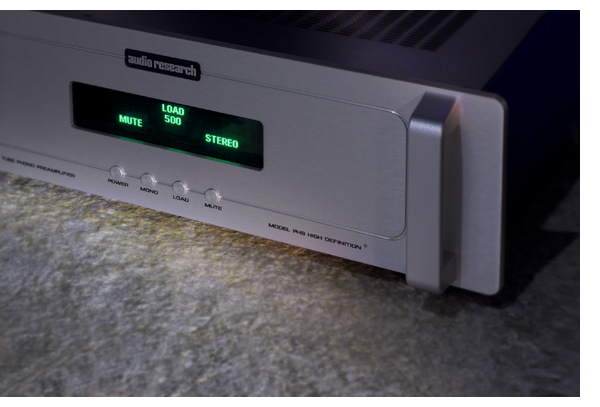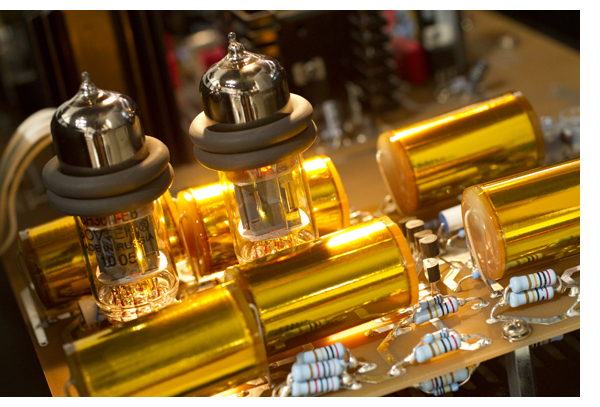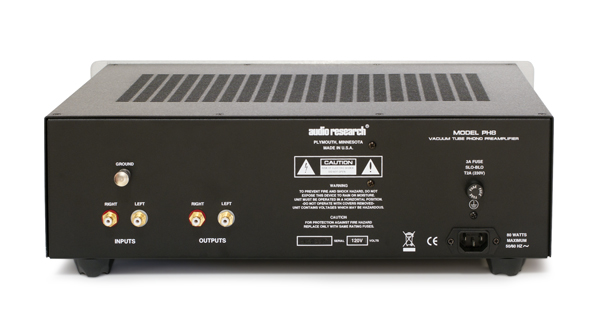Audio Research PH8 Phonostage
 Forget the long dance. You can quickly cut to the chase when evaluating the ARC PH8 phonostage by playing a familiar piano recording.
Forget the long dance. You can quickly cut to the chase when evaluating the ARC PH8 phonostage by playing a familiar piano recording.
Take Liz Story’s minimally miked Wedding Rain, a great demo album recorded on a Studer deck at 30ips. All you hear is Ms. Story and her Steinway. The PH8 captures every performance nuance. Story’s slow, lingering style often fades into the background with a melancholy feel and is punctuated by brief runs up the keyboard. The passages illustrate the lightning-fast transient response characterizing this premium phonostage. And rest assured: Revisiting the rest of your record collection will be just as much fun.
Lyra’s Kleos cartridge, currently in for review, makes for a symbiotic match with the PH8 in an all-ARC REF system. The combination provides excellent tonality, separation, dynamics, and, equally important, a very low noise floor. Utilizing the same FET/tube hybrid design as the top-of-the-range REF Phono 2 (now an SE model), the PH8 affords vinyl aficionados the best of both worlds: virtually nonexistent background noise and the tonal richness of vacuum tubes.
Vide, Bill Lordan’s epic drumming on Robin Trower’s “A Tale Untold” from For Earth Below. His kit is exquisitely rendered in both horizontal and vertical planes, and with plenty of meat, as Trower explodes into a distorted Stratocaster run on the following “Gonna Be More Suspicious.” Equally explosive is Bob Brookmeyer’s trombone on the recent Pure Pleasure release of Kansas City Revisited—another recording featuring wide dynamic swings. It shows how quickly the PH8 responds, from the softest brushwork on the drums to ear-flattening horn bursts.
The PH8 resides in the middle of ARC’s phonostage line, with an MSRP of $6,995. The PH6 (reviewed in Issue 30) is $3,495 and the REF Phono 2 SE (review in process) comes in at $12,995. Living with all three—the PH6, PH8, and the REF Phono 2 (now the SE model)—and playing them side by side through identical turntable/tonearm/cartridge/cable combinations makes it easy to discern the differences.
As with the REF Series power amplifiers, ARC phonostages share a similar physical and aesthetic design, as well as a nearly identical sonic signature. They all exhibit neutral tonality with a hint of tube warmth (albeit not at the expense of pace and timing) and an extremely low noise floor, thanks to their hybrid FET/tube design. Apparent, as well, is a similar level of user friendliness, with all controls duplicated on the front panel and remote control—a feature some may deem frivolous, but highly appreciated once in the throes of cartridge setup.
Moving up the food chain brings an increase in low-level detail and sheer dynamic drive. If you have a no-holds-barred stereo, nothing less than the REF Phono 2 SE will do. But having one means getting an analog front-end and system to match.
Shuffling Andrew Bird’s Break It Yourself between the three phonostages reveals more depth and inner detail in Bird’s violin playing. Yet, because it is not a record with wide dynamic swings or terribly deep bass lines, one could easily be convinced that stepping beyond the PH6 isn’t necessary—or perhaps, not worth the extra cash. However, upping the game to a full-scale symphonic piece or heavy rock record uncloaks the PH8’s capabilities. A similar effect is realized when going to the REF Phono 2SE.
Whether listening to the bombardment of drums in Pink Floyd’s “Another Brick in the Wall” or unraveling the layers of guitar in Mastodon’s “Blasteroid,” the PH8 possesses the horsepower to get the job done. Moving up the analog ladder means accepting fewer and fewer compromises. The more complex the music, the easier it is to discern the distinctions between the two phonostages.
Perhaps the toughest part to quantify is the realistic timbre the PH8 offers when playing acoustic instruments, another benefit the phonostage offers, along with a larger soundfield. It’s like moving your favorite band from a club to an arena. The sense of congestion that comes with lesser analog front-ends disappears. Easily illustrated by Cream’s live Royal Albert Hall (with half-speed mastering courtesy of Stan Ricker) goes from sounding like it was recorded at Ronnie Scott’s (an intimate jazz club in London), with the performers bunched together, to a proper auditorium.
So while acoustic instruments take on a more realistic, three-dimensional feel via the PH8, even electronic recordings like the Cream set benefit. Guitar enthusiasts can now hear the unmistakable tone of Clapton’s Fender cabinets rather than just generic guitar sound.
Ins, Outs, and Adjustments
The PH8 is a single-ended design featuring a pair of 6H30 triode tubes like the PH6. But where the PH6 uses all solid-state devices in the power supply, the PH8 takes advantage of the same 6550 and 6H30 tubes as the REF Phono 2SE. And while it will require tube replacement at 2,000-5,000 hour-intervals, the additional tonal saturation is well worth the small sacrifice in convenience.
Only one set of RCA inputs and outputs is available, so the PH8 cannot be placed as far from your linestage/preamplifier as the REF Phono 2 in a fully balanced system. The front panel mirrors the design of current REF components as well as the LS 17 and 27 preamplifiers. Gain is fixed at 58db, and while this level is slightly high for a MM cartridge, it’s doubtful one will employ a phonostage of this magnitude with an MM. The 47k loading option comes in handy should you prefer a moving-iron design, most of which still have 47k loading albeit a lower output of 1mv or less. Also, the Grado Statement 1 is as compatible with the PH8 as it is with the REF Phono 2SE.
The 58db gain spec is misleading—if only in the sense that the PH8 is so quiet, it works fine with MC cartridges having at least .5mv. Whereas a few all-tube phonostages expose the noise floor when is the volume turned up to modest levels, the PH8 hasn’t any problem. You will just need to get used to seeing the volume control turned up a bit higher. Running the PH8 into the ARC REF 5SE preamplifier with the .5mv output Lyra Kleos is effortless. Meanwhile, the .4mv Koetsu Urushi Blue cartridge pushes the limits of what can be expected, and the .3mv Dynavector 17D3 lacks the necessary oomph required to form a symbiotic match.
Finally, loading options are 100, 200, 500, 1000, and 47k ohms. The PH8 doesn’t possess the REF Phono 2SE’s 50 ohm and custom settings, but, again, handles the majority of MM cartridges without issue.
In the owner’s manual, Audio Research mentions the PH8 requires about 600 hours to sound its best. Sure, the unit sounds reasonably good right out of the box, yet you do need to reserve judgment until you’ve racked up serious hours on the clock. You will be surprised.
The more time I spend with the PH8, the more I am convinced of its value. True, it won’t be an impulse purchase for many listeners. But for all but the few that want to step all the way up to REF Series components, the PH8 is a great destination.
While I achieved excellent results with the AVID Volvere SP/SME V/Kleos combination, the PH8 also proves worthy via the AVID Acutus REF SP/TriPlanar combination along with Lyra’s new Atlas cartridge. The model features enough resolution to easily discern the differences between these state-of-the-art cartridges. – Jeff Dorgay
Audio Research PH8
MSRP: $6,995
www.audioresearch.com
Peripherals
| Analog Sources | AVID Volvere SP w/SME 309 AVID Acutus Reference SP w/TriPlanar and SME V |
| Cartridges | Lyra Atlas Lyra Titan i Lyra Kleos Sumiko Palo Santos Koetsu Urushi Blue |
| Preamplifier | ARC REF 5/REF 5SE |
| Power Amplifier | ARC REF 150 |
| Speakers | GamuT S9 |
| Cable | Shunyata Aurora |





